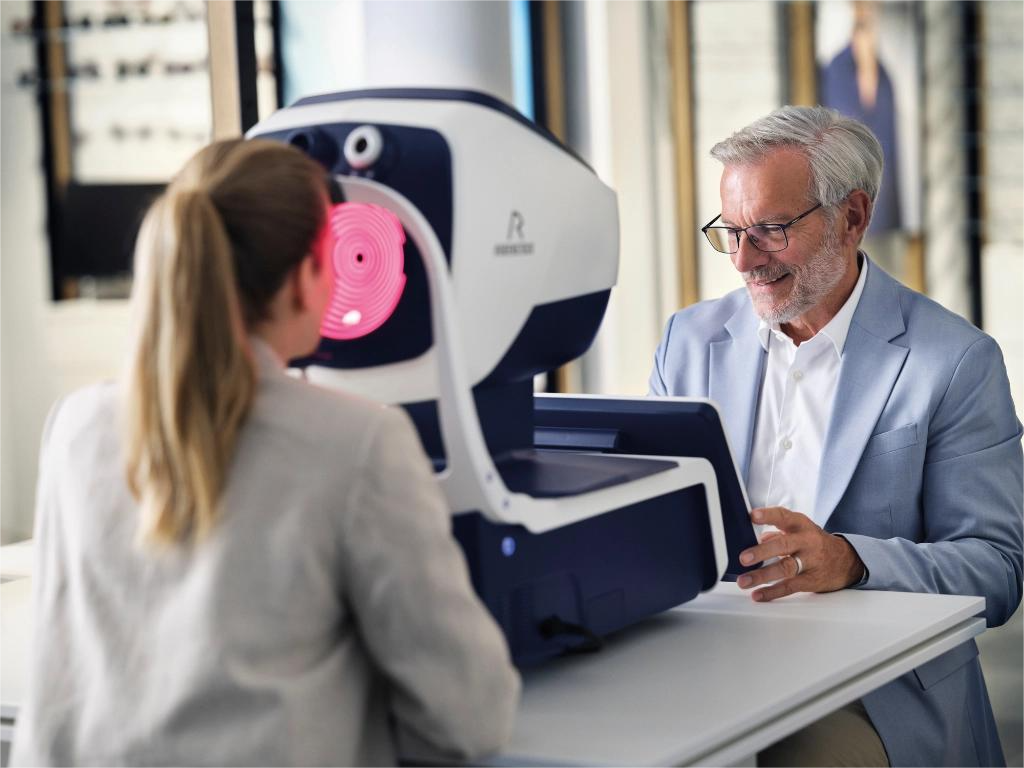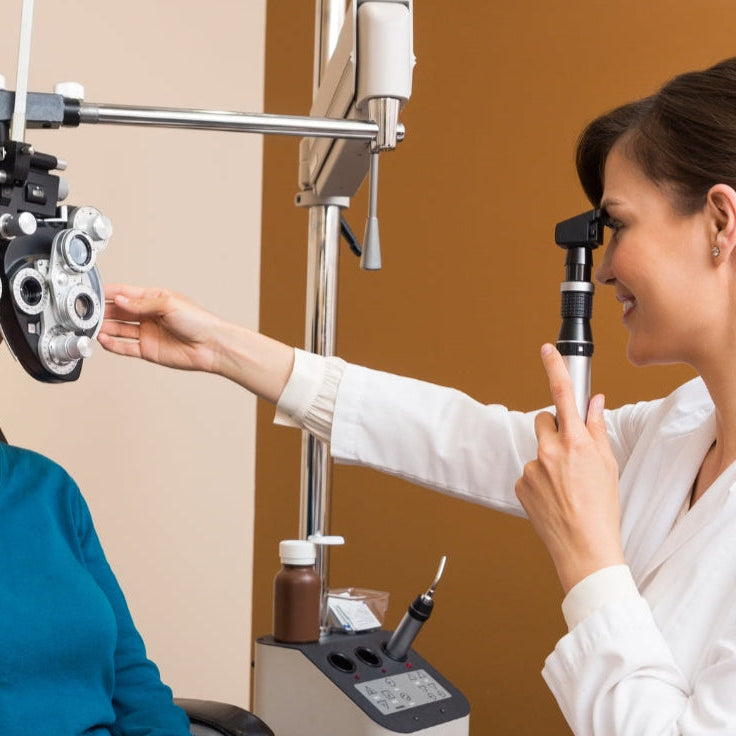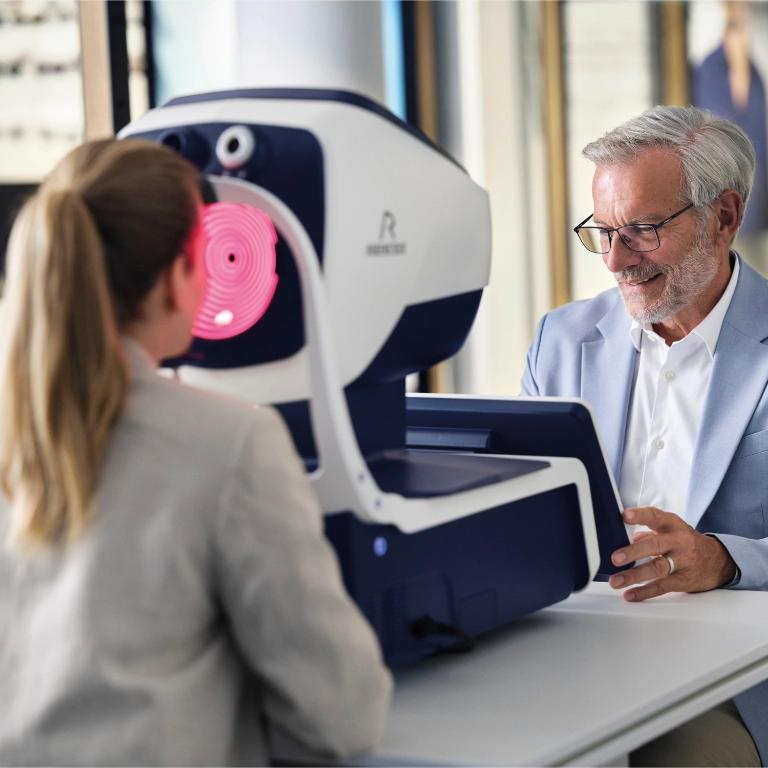General Eye Examination
Regular eye examinations are essential at every stage of life. Many eye conditions develop gradually and without obvious symptoms—but early detection can significantly improve treatment outcomes, particularly as we age and eye conditions become more common.
At HC EYECARE, we use the most advanced diagnostic technology to examine your eyes in exceptional detail. This allows our optometrists to identify not only vision-related concerns, but also signs of general health conditions that may first present in the retina.
Our commitment to advanced eye care goes beyond simply helping you see better—it’s about protecting your long-term health and well-being through early, proactive care.
Many Australians remain undiagnosed with chronic eye conditions, so don’t delay. Book an eye test today.
We recommend that you have an eye test at least every two years, or more frequently if recommended by your Optometrist.

100% Digital Comprehensive Eye Test
The DNEye® Scanner begins with a comprehensive eye health screening—completed in just two minutes. It measures over 7,000 data points, including vision, night vision, prescription, light sensitivity, and corneal topography. This detailed scan creates a unique visual profile, and transfers all measurements to the lens, enabling the creation of highly individualised lenses. The result is sharper vision, improved contrast, and better visual comfort, especially in low-light or high-glare conditions.
Understand Your Eyes in Great Detail
At HC EYECARE, we have invested in most advanced technology to take a deeper look at your eyes. The Ultra Wide Digital Retinal Scan and Optical Coherence Tomography (OCT) by ZEISS takes eye health to another level – providing an extensive view of the back of your eyes.
Ultra Wide Digital Retinal Scan By Zeiss Clarus
An Ultra Wide Digital Retinal Scan captures 200 degrees of the retina – four times more than a conventional digital retinal scan. This covers approximately 82% of the retinal surface, allowing our optometrists to detect early signs of blood vessel abnormalities, glaucoma, diabetic eye change, macular degeneration.
*Fee apply.

Optical Coherence Tomography (OCT) By Zeiss Cirrus
To aid in the detection and monitoring of serious eye diseases, we use an Optical Coherence Tomography (OCT). It takes a 3D image of the eye’s internal structures, giving us a more detailed picture of your eye health.
When to Have a Scan
We recommend having an eye scan at least every two years with your eye test. If you’re over 40 or experiencing vision symptoms, a yearly exam is better because detecting problems early can broaden treatment options.
If you’re experiencing any of the following symptoms, please call us or book an eye test appointment straight away so we can help you find out what’s wrong:
- You see flashes of light
- You see dark spots or empty patches
- Trouble reading or concentrating on any activity that requires fine vision
- Straight lines appear wavy or bent
- Faces are hard to see
If you’re not sure which scan is right for you, just talk to one of our Optometrists.
Vision & Prescription Check
Cost: Bulk billed for eligible Medicare card holders and services
Time: 20-30 minutes
We will check your vision at various distances to identify any issues with your day-to-day vision. We will also provide you with professional advice on your eye health and the best way to address any problems using glasses, contact lenses, or sunglasses.
Comprehensive Eye Examination
Cost: Gap payment $60
Time: 40minutes
A comprehensive eye exam includes a thorough evaluation of your eye health to detect conditions such as glaucoma, macular degeneration, and cataracts. Using our Ultra Wide Digital Retinal Scan, which captures an image four times larger than a standard retinal scan, we can examine a broader area of the retina. These detailed images are securely stored in your eye health record, allowing your Optometrist to monitor and compare changes over time for early detection and better management of eye diseases.
Dry Eye Consultation
Cost: Gap payment $60
Time: 40minutes
Dry eye consultation involves a thorough assessment of your tear quality, eye surface health, and the causes of dryness.Based on the results, our optometrists will develop a personalised management plan tailored to your condition, budget and lifestyle to ensure the best possible outcomes.
Eyecare Tips
Looking for help
If you recognise any of the following disorders or conditions, please book an eye test and our optometrists will help explain what’s going on and what needs to be done.
Myopia (Nearsightedness)
Myopia is a condition where you can see close objects clearly, but objects at a distance appear blurry. This occurs when the eye focuses images in front of the retina rather than directly on it. People with myopia often struggle to read road signs, watch television clearly, or recognise faces from afar. Myopia typically develops in childhood and can progress with age, but it can be corrected with glasses, contact lenses, or refractive surgery.
Myopia control involves strategies to slow the progression of myopia in children and young adults. These include specialised contact lenses, orthokeratology (overnight corneal reshaping), and certain eye drops. Early intervention can help reduce the risk of developing high myopia and related eye complications later in life.
Hyperopia (Farsightedness)
Hyperopia causes difficulty focusing on objects that are close, while distance vision usually remains sharp. This happens when the eye’s shape causes light to focus behind the retina. Symptoms often include eye fatigue, headaches, and discomfort, especially after prolonged close-up activities like reading or working on a computer. Difficulty seeing small text on smartphones or other devices is also common. Hyperopia can be corrected with prescription lenses or other treatments.
Astigmatism (Irregular Corneal Shape)
Astigmatism results from an irregular curvature of the cornea or lens, causing distorted or blurred vision at all distances. Unlike a perfectly round cornea, an astigmatic eye’s surface is shaped more like a football, which prevents light from focusing evenly on the retina. Astigmatism is a very common condition and is not considered a disease. It can be easily corrected with specially designed glasses or contact lenses.
Presbyopia (Age-Related Farsightedness)
Presbyopia typically begins after age 40 and is a natural part of the aging process. It occurs when the eye’s lens loses flexibility, making it harder to focus on close objects. This is why many people notice difficulty reading small print, menus in low light, or needing to hold books or phones farther away. Presbyopia can be managed with reading glasses, multifocal lenses, or other vision correction options.
Diatebes and Eye Health
Diabetes can significantly impact your eyes by damaging the blood vessels in the retina, a condition known as diabetic retinopathy. This is a leading cause of vision loss and often develops without noticeable symptoms in its early stages. High blood sugar levels cause the retinal vessels to leak or close off, impairing vision and potentially leading to blindness if untreated. Additionally, people with diabetes have an increased risk of cataracts and glaucoma. Regular, thorough eye examinations and advanced retinal imaging are critical for early detection and timely treatment to protect your vision and overall eye health.
Age-Related Macular Degeneration (AMD)
AMD is a progressive eye condition that primarily affects central vision and becomes more common with age, especially after 40. It is the leading cause of vision loss in Australia. There are two forms: dry AMD, which causes gradual degeneration of the central retina, and wet AMD, which involves abnormal blood vessel growth that can rapidly damage vision. Early diagnosis and treatment—particularly for wet AMD—are crucial to preserving vision and slowing progression.
Cataracts
Cataracts develop when the eye’s natural lens becomes cloudy, reducing vision clarity. This process generally occurs gradually with age and is a leading cause of vision impairment worldwide. Symptoms include hazy or blurred vision, colours appearing faded or yellowed, increased sensitivity to glare, and difficulty seeing in low light. Cataracts can be treated effectively with surgery to replace the cloudy lens with a clear artificial one.
Dry Eyes
Dry eye syndrome occurs when the eyes do not produce enough tears or when the tears evaporate too quickly due to an imbalance in their composition. This leads to dryness, irritation, and inflammation of the surface of the eye. Symptoms include burning, itching, redness, a gritty sensation, and occasional blurred vision. Interestingly, eyes may sometimes produce excess tears as a reflex to dryness. Treatment options include artificial tears, lifestyle adjustments, and specialized therapies.
Glaucoma
Glaucoma is a group of eye conditions that damage the optic nerve, often due to increased pressure inside the eye. It usually affects peripheral (side) vision first and can progress without noticeable symptoms until significant vision loss occurs. If untreated, glaucoma can lead to permanent blindness. Regular eye exams are essential for early detection, allowing treatment to slow or prevent further damage.
Spots and Floaters
Floaters appear as small shapes—such as dots, cobwebs, or thread-like strands—that drift across your field of vision. They are caused by tiny clumps of gel or cells inside the vitreous, the clear gel filling the eye. While common and generally harmless, a sudden increase in floaters or flashes of light may indicate a retinal tear or detachment, which requires urgent medical attention. If you notice such changes, please contact your nearest HC EYECARE clinic immediately.







